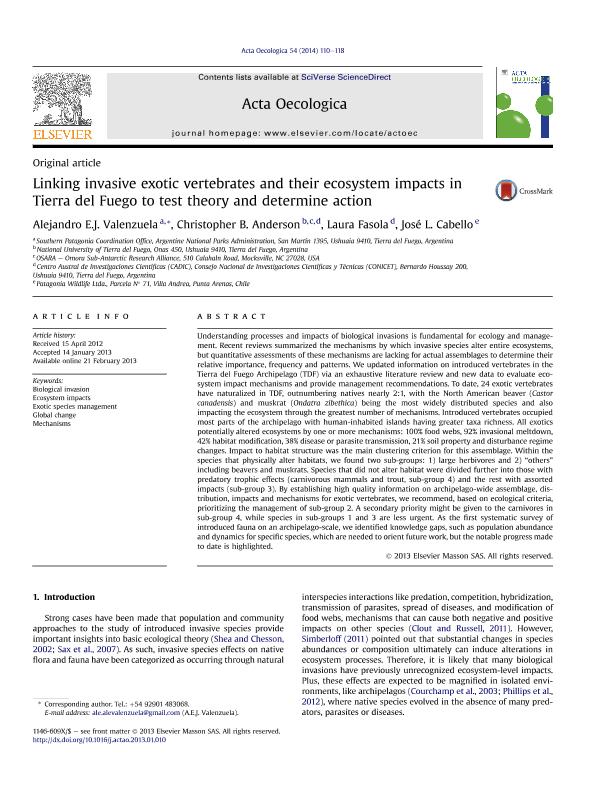Mostrar el registro sencillo del ítem
dc.contributor.author
Valenzuela, Alejandro Eduardo Jorge
dc.contributor.author
Anderson, Christopher Brian

dc.contributor.author
Fasola, Laura

dc.contributor.author
Cabello, José Luís
dc.date.available
2016-04-28T20:12:28Z
dc.date.issued
2014-01
dc.identifier.citation
Valenzuela, Alejandro Eduardo Jorge; Anderson, Christopher Brian; Fasola, Laura; Cabello, José Luís; Linking invasive exotic species and their ecosystem impacts in Tierra del Fuego to test theory and determine action; Elsevier; Acta Oecologica; 54; 1-2014; 110-118
dc.identifier.issn
1146-609X
dc.identifier.uri
http://hdl.handle.net/11336/5433
dc.description.abstract
Understanding processes and impacts of biological invasions is fundamental for ecology and management. Recent reviews summarized the mechanisms by which invasive species alter entire ecosystems, but quantitative assessments of these mechanisms are lacking for actual assemblages to determine their relative importance, frequency and patterns. We updated information on introduced vertebrates in the Tierra del Fuego Archipelago (TDF) via an exhaustive literature review and new data to evaluate ecosystem impact mechanisms and provide management recommendations. To date, 24 exotic vertebrates have naturalized in TDF, outnumbering natives nearly 2:1, with the North American beaver (Castor canadensis) and muskrat (Ondatra zibethica) being the most widely distributed species and also impacting the ecosystem through the greatest number of mechanisms. Introduced vertebrates occupied most parts of the archipelago with human-inhabited islands having greater taxa richness. All exotics potentially altered ecosystems by one or more mechanisms: 100% food webs, 92% invasional meltdown, 42% habitat modification, 38% disease or parasite transmission, 21% soil property and disturbance regime changes. Impact to habitat structure was the main clustering criterion for this assemblage. Within the species that physically alter habitats, we found two sub-groups: 1) large herbivores and 2) ?others? including beavers and muskrats. Species that did not alter habitat were divided further into those with predatory trophic effects (carnivorous mammals and trout, sub-group 4) and the rest with assorted impacts (sub-group 3). By establishing high quality information on archipelago-wide assemblage, distribution, impacts and mechanisms for exotic vertebrates, we recommend, based on ecological criteria, prioritizing the management of sub-group 2. A secondary priority might be given to the carnivores in sub-group 4, while species in sub-groups 1 and 3 are less urgent. As the first systematic survey of introduced fauna on an archipelago-scale, we identified knowledge gaps, such as population abundance and dynamics for specific species, which are needed to orient future work, but the notable progress made to date is highlighted.
dc.format
application/pdf
dc.language.iso
eng
dc.publisher
Elsevier

dc.rights
info:eu-repo/semantics/openAccess
dc.rights.uri
https://creativecommons.org/licenses/by-nc-nd/2.5/ar/
dc.subject
Biological Invasions
dc.subject
Ecosystem Impacts
dc.subject
Exotic Species Management
dc.subject
Global Change
dc.subject.classification
Ecología

dc.subject.classification
Ciencias Biológicas

dc.subject.classification
CIENCIAS NATURALES Y EXACTAS

dc.title
Linking invasive exotic species and their ecosystem impacts in Tierra del Fuego to test theory and determine action
dc.type
info:eu-repo/semantics/article
dc.type
info:ar-repo/semantics/artículo
dc.type
info:eu-repo/semantics/publishedVersion
dc.date.updated
2016-05-06 15:52:43.262787-03
dc.journal.volume
54
dc.journal.pagination
110-118
dc.journal.pais
Francia

dc.journal.ciudad
Paris
dc.description.fil
Fil: Valenzuela, Alejandro Eduardo Jorge. Administración de Parques Nacionales Argentinos; Argentina
dc.description.fil
Fil: Anderson, Christopher Brian. Consejo Nacional de Investigaciones Científicas y Técnicas. Centro Austral de Investigaciones Científicas; Argentina. Universidad Nacional de Tierra del Fuego; Argentina. Omora Sub-Antarctic Research Alliance; Estados Unidos
dc.description.fil
Fil: Fasola, Laura. Consejo Nacional de Investigaciones Científicas y Técnicas. Centro Austral de Investigaciones Científicas; Argentina
dc.description.fil
Fil: Cabello, José Luís. Patagonia Wildlife Ltda.; Argentina
dc.journal.title
Acta Oecologica

dc.relation.alternativeid
info:eu-repo/semantics/altIdentifier/url/http://www.sciencedirect.com/science/article/pii/S1146609X13000118
dc.relation.alternativeid
info:eu-repo/semantics/altIdentifier/doi/10.1016/j.actao.2013.01.010
dc.relation.alternativeid
info:eu-repo/semantics/altIdentifier/doi/http://dx.doi.org/10.1016/j.actao.2013.01.010
Archivos asociados
